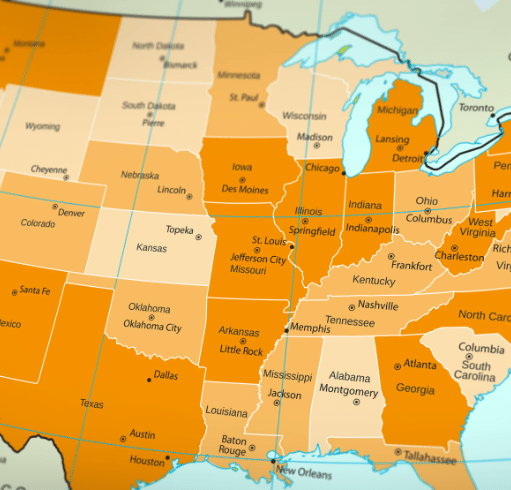How Extreme Weather Affects Shipping
Melton Logistics – 08/22/2024
Extreme weather continues to disrupt the lives and economies of millions of people every year. Even as logistics professionals and their systems grow more proficient at safeguarding vulnerabilities within the global supply chain, hurricanes, flooding, snow and ice storms, earthquakes, wildfires, high winds and tornadoes can decimate an infrastructure and abruptly stop those unprepared businesses.
The outlook for 2024 is tumultuous; companies must evaluate their current shipping practices in preparation for weather-related hazards.

Weather Events Expected in 2024
Natural disasters wreak havoc on roads, tunnels, and bridges crucial to preferred shipping routes, and for companies focused on maintaining a lean inventory, it can heavily impact the speed and frequency of a company’s order fulfillment. However, it doesn’t take a Category 5 hurricane to impact supply chains. Less extreme weather can also heavily impact truck drivers, with low visibility, unexpected traffic jams, or even power outages preventing them from picking up or delivering products on time. All these events, regardless of their severity, have the potential to greatly affect cost. Early forecasts predicted a “very active” 2024 hurricane season with an above-average number of major storms expected to directly impact the US. So far, we’ve already been hit by over 20 named storms and several hurricanes, one of which was the earliest category-5 Atlantic hurricane on record. These conditions are predicted to continue into the fall, meaning the time to prepare is now.
Trucking isn’t the only mode of transportation expected to suffer setbacks in 2024 due to inclement weather. For a third straight year, drought conditions will likely force alternative means of transportation in areas reliant upon minimum water levels – particularly along the Mississippi River. Along the coasts, ports frequently bear the brunt of harsh storms and flooding as hurricanes make their way ashore. Likewise, less-than-ideal flight conditions can easily sideline airfreight and dramatically disrupt sensitive supply chains depending upon air transport. Further, increased wear and tear on runways in cases of snow, thunderstorms, and escalated tornado conditions also create costly delays and repairs.
4 Ways Weather Affects Shipping
Rates – One bad storm can destroy even the best-laid plans and budgets. It is estimated that adverse weather conditions cost the shipping industry more than $3.5 billion annually. Trying to account for weather in the budgeting process is a difficult task, as the unpredictable nature of harsh winters and tropical storms introduces a plethora of variables to the equation annually.
Capacity – Bad weather’s most obvious impact is in limiting the number of trucks on the road. Getting stuck in a sudden blizzard or slowed weather-related traffic prevents trucks from delivering products or getting to their next pickup, thereby negatively impacting shipping revenue and costing shippers money in delays.
Transit Times – Despite costly natural disasters increasing in frequency each year, in a society that now expects instant gratification, the speed at which customers expect their shipped goods has only accelerated. Although roughly 70% of the U.S. population and roads reside in commonly snowy regions, customer expectations fail to account for such challenges. Slow transit times and delayed deliveries are inevitable side effects of inclement weather, and it takes a combination of exemplary communication and careful planning to ensure that customers are well taken care of.
Fuel – The fuel supply chain is an entity all its own. Fluctuating oil prices, refinery shutdowns and damaged infrastructure all impact downstream fuel prices throughout the disaster-recovery process, making fuel-related challenges a pain point for companies managing supply chains and harsh weather conditions.
Preparing Your Supply Chain for Extreme Weather
Natural disasters are aptly named – they don’t distinguish between businesses that are prepared and those that are not. They simply wreak havoc on local systems and leave transportation services to develop solutions that will help deliver their products. These solutions are generally more effective when implemented as preventative measures, and not in response to an already active disaster. Here are three keys to mitigating the risks of extreme weather before it strikes:
Establish Frequent Communication and Transparency – Navigating a natural disaster demands a fast reaction time, which can only exist in businesses with efficient top-to-bottom communication practices. Communicating changes in plans or delays is a huge time and money-saver, but can only be accomplished if your supply chain has complete transparency at every phase of the transportation/shipping process.
Staying connected with your people, transportation providers, and your goods in transit is critical. Knowing precisely where your goods are located, what conditions they require to arrive at their destination safely, and what changes can be made to accommodate poor weather will prompt faster and more effective decision-making.

Identify Regional Vulnerabilities – While harsh weather is impossible to predict, some areas exist in zones likely to experience hurricanes, tornadoes, flooding, and ice storms more regularly than the rest of the country. Companies doing business with states along the Gulf Coast will want to establish alternative routes in cases of tropical storms from the Atlantic. Businesses shipping to the West Coast should create similarly detailed backup plans to safeguard against summer wildfire season. Understanding your region’s weather/disaster-related challenges is key to anticipating disasters and developing effective strategies to keep your business operational.
Diversify Your Backup Carriers – Limiting your business to a small core of carriers dramatically increases the risk of supply chain disruptions and not just in cases of bad weather. Diversifying your carrier network ensures a simple, minor incident won’t cripple your entire business as you will have access to a variety of other options vetted and waiting to provide transportation services. Establishing a flexible supply chain through carrier diversification safeguards your operations from shutting down in times of crisis, and maintains important business relationships without sacrificing service levels.
Fortify Your Supply Chain with Melton Logistics
Mitigating the dangers and delays posed by natural disasters is all about anticipating and quickly adapting to the circumstances presented. With an extensively vetted group of suppliers, integrated technology solutions and over 21 years of industry expertise, 3PLs like Melton Logistics are well-equipped to guide our business partners through unforeseen circumstances with ease. Learn more about the services Melton Logistics can provide for your business here.
